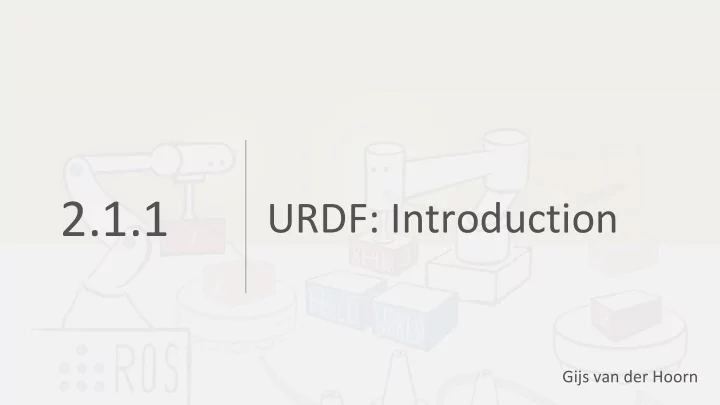

2.1.1 URDF: Introduction Gijs van der Hoorn
URDF? • robot model storage format? • simulation format? • required?
URDF – What is it? • Domain specific modeling language (DSML) • XML • Stores: • Kinematics • Dynamics parameters and other meta-data • Human & machine readable/writable
URDF – What is it (2)? • ROS specific file-format based on XML • Stores: • Robot body layout • Appearance • Extra information (joint position limits, joint velocity limits,..) • Names and concepts from robotics domains
URDF – Implementation • Text file • XML tags standardized in URDF “standard” • File references using Uniform Resource Locators (URLs) • 3D mesh files
Contents • Mostly <link> and <joint> elements • <link> s: robot structure • <joint> s: connections and motion constraints
Example tiny_robot.urdf <robot name="tiny_robot"> <link name="link_1" /> </robot> link_1
Example (2) tiny_robot.urdf <robot name="tiny_robot"> <link name="link_1" /> <link name="link_2" /> <joint name="joint_1" type=".."> J1 <parent link="link_1" /> <child link="link_2" /> link_1 </joint> </robot>
Joint types 1. Fixed: rigid connection 2. Revolute: 1D rotation 3. Continuous: unlimited revolute 4. Prismatic: 1D translation 5. Planar: 2D translation 6. Floating: unlimited 6D
Standardisation • REP 103 - Standard Units of Measure and Coordinate Conventions • Right-handed coordinate system • X+ (forward) and Y+ (left) → Z+ (up) • SI units: • Lengths: meters • Angles: radians
End of part 1 - recap • Specialization of XML • Model robots with links and joints • Various joint types • Use 3D mesh files for detailed appearances • SI units for lengths (meters) and angles (radians) Try it yourself!
Recommend
More recommend